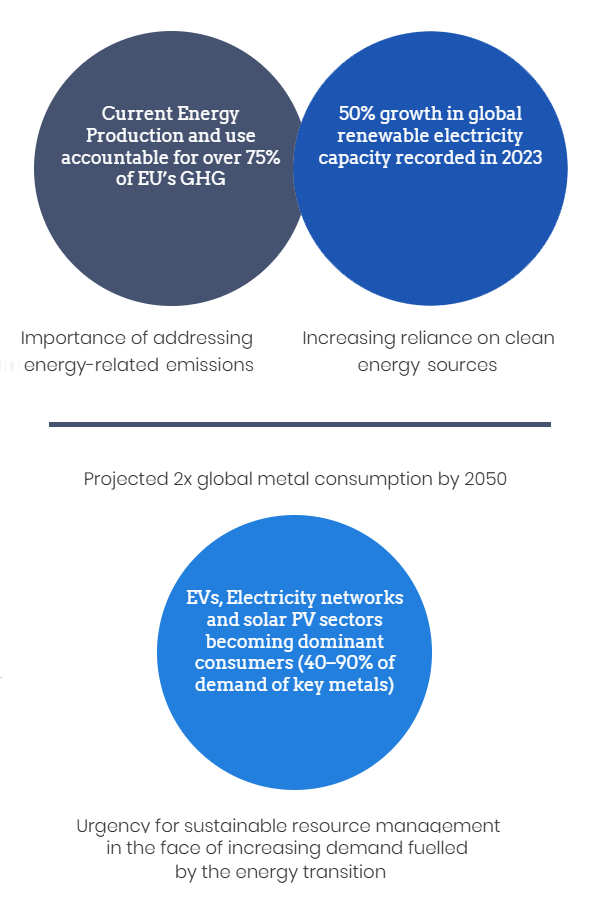Key drivers of our initiative
Current Energy Production and use accountable for over 75% of EU’s GHG
Importance of addressing energy-related emissions
50% growth in global renewable electricity capacity recorded in 2023
Increasing reliance on clean energy sources
Projected 2x global metal consumption by 2050
EVs, Electricity networks and solar PV sectors becoming dominant consumers (40–90% of demand of key metals)
Urgency for sustainable resource management in the face of increasing demand fuelled by the energy transition

Navigating the path to Net-Zero through clean electrification
Motivated by the European Union’s commitment to achieving climate neutrality by 2050 and addressing the substantial 75% share of greenhouse gas emissions (GHG) attributed to energy production and use, SOLMATE is dedicated to facilitating a secure, affordable and environmentally friendly energy transition.
As energy transition gathers pace, clean energy technologies emerge as the fastest-growing demand segment. The success of this transition is directly dependant on, and thus vulnerable to the availability of metals, especially Critical Raw Materials (CRMs). The primary driver is the EV battery industry, closely followed by the production of solar PV panels.
Overview of various CRMs
included in batteries and PV panels

- The European Green Deal; also an overview of background information
- Net Zero Industry Act
- Critical Raw Materials Act
- Inforgraphic – An EU critical raw materials act for the future of EU supply chain
- End-of-life Management Solar Photovoltaic Panels [IRENA]
- The Role of Critical Minerals in Clean Energy Transitions [IEA Report]
- COP28: Global renewables and energy efficiency pledge
- Waste Framework Directive
- IEA Renewables report
- Raw materials demand for wind and solar PV technologies in the transition towards a decarbonised energy system [JRC]
- Executive summary – Solar PV Global Supply Chains – Analysis – IEA
- Metals for Clean Energy: Pathways to solving Europe’s raw materials challenge
Circular economy potential for PV panels and EV batteries
Ensuring that products at the end of their life, like EV batteries and PV modules, follow the guidelines standing at the core of the Waste Framework Directive is like giving them a second chance at life. It not only helps them find useful ways to extend their lifetime beyond their initial use but also ensures they’re recycled properly, moving us closer to a near zero waste approach.
Coupling 2nd life batteries and PV panels could establish new sustainable business models. But exploring this solution raises additional challenges, some of them addressed by the SOLMATE research project during the course of 4 years: the need for low-cost automatic dismantling, testing, and certification protocols to ensure the reliable operation of these resources beyond their initial utilisation. This approach aims to establish reliable and cost-effective decentralised energy systems for various markets such as the emerging Agri-PV market and low-income communities, where electricity is not yet an accessible commodity.
When repurposing solutions encounter application difficulties, EV batteries and PV panels need to be disposed and recycled, aiming to recover all available materials (metals, compounds, electrolytes, polymers, active materials etc).

Our mission
As the world anticipates a significant increase in metal demand by 2050, particularly driven by the development and adoption of clean technologies, SOLMATE navigates these challenges to ensure a sustainable supply chain for a green transition. More precisely, how will we do that? By establishing a framework for the reuse and recycling of PV solar panels and EV batteries in emerging markets and high-value applications.
Addressed challenges in SOLMATE
The EU policy context, corroborated with a massive amount of PV panels expected to become available for reuse or recycling soon, raise emerging challenges that SOLMATE will try to address:
- Lack of technologies to properly characterise and sort the working modules in efficient and low-cost ways
- Insufficient low-cost testing and certification methodologies (e.g., safety, performance, warranty)
- Lack of technologies for automatic dismantling and sorting
- Unregulated 2nd life PV market
- Technological gaps in sorting non-working modules to ensure effective separation of the feedstock from the source and further facilitate the recycling of materials and their valorisation in high added value products.
- Low cost and reliable testing methodologies for EV batteries and energy management systems, essential to ensure the extended warranty of 2nd life batteries for stationary applications for prolonged durations (e.g.,10 years)
- Lack of green and economically viable processes for the recycling of valuable critical raw materials available in batteries
